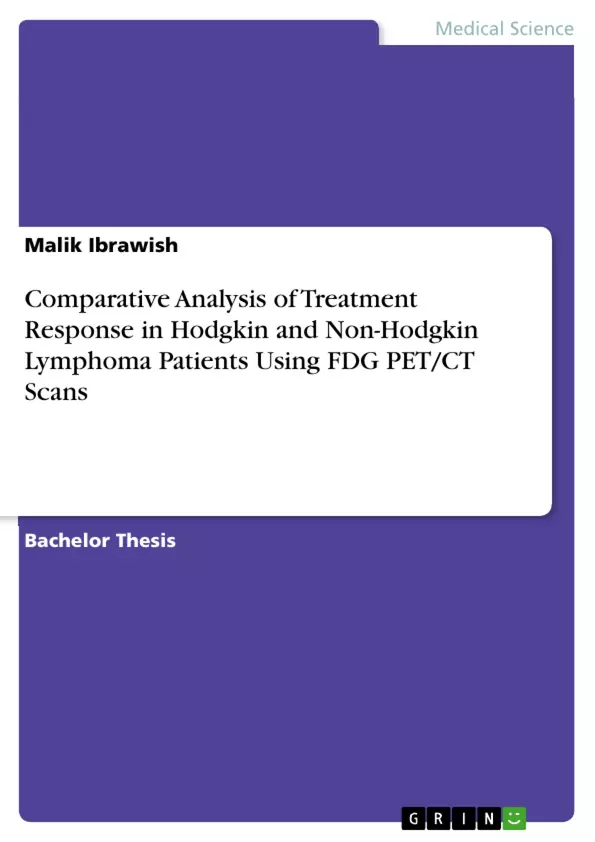This study seeks to compare the treatment responses of Hodgkin and non-Hodgkin lymphoma patients using FDG PET/CT scans. 152 patients with histologically confirmed Hodgkin and non-Hodgkin lymphomas, who had undergone FDG PET/CT imaging for evaluating their treatment response after their initial chemotherapy regimen, were included in a retrospective study. The findings revealed that Hodgkin's lymphoma was more prevalent in females, and both types of lymphomas showed similar complete metabolic responses. However, Hodgkin's lymphoma demonstrated higher mild/high partial responses, and non-Hodgkin's lymphoma showed lower progressive metabolic disease.
Inhaltsverzeichnis (Table of Contents)
- ACKNOWLEDGEMENT.
- LIST OF FIGURES
- LIST of TABLES
- LIST OF ABBRIVIATION.
- ABSTRACT.
- Introduction
- Background of the Study:
- Problem Statement.
- Justification..
- Study Objectives.
- Study Question
- THEORY AND LITERATURE REVIEW.
- Introduction........
- lymphoma:...
- Hodgkin lymphoma......
- non-Hodgkin lymphomas....
- Symmetrical Study.
- METHODS AND MATERIALS
- Introduction........
- Study Design and Image Acquisition:.
- Ethical approval.
- Study population
- Study sample size..
- data collection
- inclusion and exclusion criteria
- Study device and instruments
- Data Analysis...
- FDG PET/CT image analysis.
- Statistical Analysis
- RESULTS AND DISCUSSION
- Introduction..
- Age, Gender, and Cancer Type Analysis..
- Gender-Based Distribution of Cancer Types an Analysis of Frequency and Percentages ......
- study parameters
- Percentage of Follow-up sessions between both cancers
- The differences percentage between HL and NHL in the treatment provided
- The Follow-up examination viability
- Timing of the follow-up examination.
- Cancer Location ......
- CONCLUSION AND RECOMMENDATIONS
- Conclusion:
- Recommendation:
- Limitation:
- LIST OF FIGURES
- LIST of TABLES
Zielsetzung und Themenschwerpunkte (Objectives and Key Themes)
This study aims to compare the treatment response of Hodgkin Lymphoma (HL) and non-Hodgkin Lymphoma (NHL) patients by analyzing data obtained from FDG PET/CT imaging. The research focuses on analyzing various parameters to understand the effectiveness of treatment and the characteristics of these cancer types.
- Treatment response in HL and NHL patients
- Analysis of FDG PET/CT imaging data for diagnostic and follow-up purposes
- Comparison of demographic factors and cancer characteristics between HL and NHL patients
- Evaluation of the effectiveness of treatment interventions for both HL and NHL
- Examination of the impact of follow-up sessions on treatment outcomes
Zusammenfassung der Kapitel (Chapter Summaries)
The introduction of the study provides a comprehensive overview of the background, problem statement, justification, objectives, and research question related to the comparison of treatment response in HL and NHL patients using FDG PET/CT imaging. It highlights the importance of the study and its contribution to the field of medical imaging and cancer research.
Chapter 2 delves into the theoretical framework and literature review surrounding lymphoma. This chapter provides a detailed overview of both Hodgkin lymphoma and non-Hodgkin lymphoma, discussing their characteristics, diagnostic criteria, and treatment approaches. It also presents relevant research findings and studies related to the use of FDG PET/CT imaging in diagnosing and monitoring lymphoma.
Chapter 3 focuses on the methods and materials used in the study. It describes the study design, image acquisition procedures, ethical considerations, and data analysis techniques. The chapter outlines the specific protocols followed for FDG PET/CT imaging, participant selection criteria, and the statistical methods employed to analyze the collected data. This section ensures the rigor and transparency of the research methodology.
Chapter 4 presents the results and discussion of the study findings. It analyzes the data collected from the FDG PET/CT imaging of both HL and NHL patients, focusing on demographic factors, treatment response, and the effectiveness of follow-up sessions. The chapter interprets the findings in the context of existing literature and discusses potential implications for clinical practice. The detailed analysis of the study findings allows for a thorough examination of the treatment response differences between HL and NHL patients.
Schlüsselwörter (Keywords)
The core focus of this research revolves around the analysis of FDG PET/CT imaging data in the context of Hodgkin Lymphoma (HL) and non-Hodgkin Lymphoma (NHL) patients. The study investigates treatment response, diagnostic accuracy, follow-up procedures, and demographic factors associated with both cancer types. Key terms include FDG PET/CT imaging, treatment response, Hodgkin lymphoma, non-Hodgkin lymphoma, diagnostic accuracy, follow-up sessions, demographic characteristics, and statistical analysis.
- Citation du texte
- Malik Ibrawish (Auteur), 2023, Comparative Analysis of Treatment Response in Hodgkin and Non-Hodgkin Lymphoma Patients Using FDG PET/CT Scans, Munich, GRIN Verlag, https://www.grin.com/document/1371435



